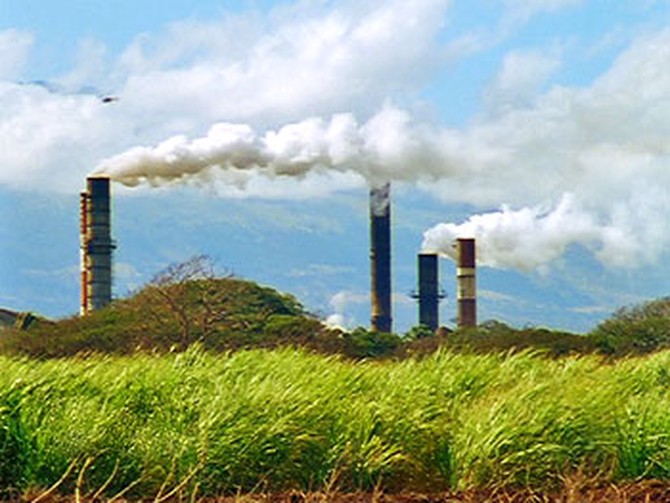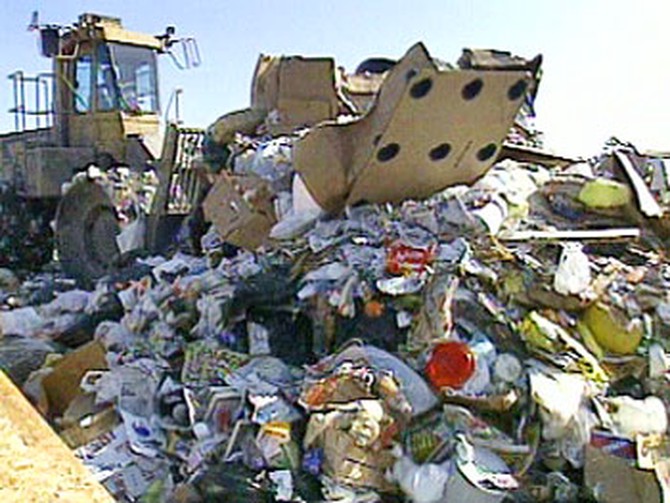Global Warming 101

Actor Leonardo DiCaprio shares what he believes is the most pressing environmental issue of our time: global warming. And Leo's definitely not alone—many scientists have been warning the public for years that the Earth is getting hotter. Some say that if drastic measures aren't taken to stop it, global warming may cause catastrophic results for the billions of people living on our planet.
Leo says global warming is not only the number one issue affecting the environment—it's one of the most important issues facing all of humanity. "It's something that's going to affect not only us, but our children and our grandchildren…and generations to come," says Leo.
Leo says global warming is not only the number one issue affecting the environment—it's one of the most important issues facing all of humanity. "It's something that's going to affect not only us, but our children and our grandchildren…and generations to come," says Leo.

The theory of global warming is both controversial and political. But most of us aren't even sure what it is. Here's your chance to get informed!
The atmosphere surrounding the Earth contains something called "greenhouse gases." Certain gases that exist naturally in the atmosphere trap heat that would otherwise escape into space. It's like building a blanket over the Earth. And it's a good thing, too, because otherwise the Earth would be 60 degrees colder than it is now.
The problem is human beings are thickening that blanket by adding air pollution to the atmosphere. It's estimated that burning oil and other fossil fuels have pumped over 700 billion tons of carbon dioxide pollution into the atmosphere! And that's what experts reason is causing the Earth to warm—a thicker blanket means a warmer planet.
The atmosphere surrounding the Earth contains something called "greenhouse gases." Certain gases that exist naturally in the atmosphere trap heat that would otherwise escape into space. It's like building a blanket over the Earth. And it's a good thing, too, because otherwise the Earth would be 60 degrees colder than it is now.
The problem is human beings are thickening that blanket by adding air pollution to the atmosphere. It's estimated that burning oil and other fossil fuels have pumped over 700 billion tons of carbon dioxide pollution into the atmosphere! And that's what experts reason is causing the Earth to warm—a thicker blanket means a warmer planet.

Dr. Michael Oppenheimer is a professor of Geosciences and International Affairs at Princeton University, and a leading scholar on global warming. For Dr. Oppenheimer, global warming is a scientific fact that could "remake the face of the Earth." "Scientists agree there's no longer really any argument," says Oppenheimer. "The climate is changing. Human beings are largely responsible, and it's just going to keep getting warmer until we act to remove the pollution."
From studying climate patterns over time, Dr. Oppenheimer says global warming is not a natural shift. "The last 50 years stick out like a sore thumb," he says. "The temperature's gone up and up and up. It bears the imprint of human activity."
The 1990s alone were the warmest decade of the last century. Temperatures rose one degree Fahrenheit. That may not sound like a lot, but in scientific terms, that's a big deal. "Over the next 10 to 30 years, Earth could be as much as three degrees warmer than today," says Dr. Oppenheimer. "By 50 years from now, Earth could be five degrees or so warmer than today."
From studying climate patterns over time, Dr. Oppenheimer says global warming is not a natural shift. "The last 50 years stick out like a sore thumb," he says. "The temperature's gone up and up and up. It bears the imprint of human activity."
The 1990s alone were the warmest decade of the last century. Temperatures rose one degree Fahrenheit. That may not sound like a lot, but in scientific terms, that's a big deal. "Over the next 10 to 30 years, Earth could be as much as three degrees warmer than today," says Dr. Oppenheimer. "By 50 years from now, Earth could be five degrees or so warmer than today."

Scientists say that if you want to gauge the affects of global warming in the future, keep your eye on the Arctic. NASA images reveal that Arctic sea ice has been melting drastically over the last 25 years. One study found almost 400,000 square miles of sea ice is already gone. As rising temperatures melt away glaciers, sea levels around the world are rising.
That could spell disaster for the over 100 million people living within three feet of sea level. Some coastline villages like Point Barrow are slowly falling into the rising sea. The loss of all that ice in the Arctic could mean hotter and more deadly summers for the rest of us. If the temperatures continue to rise, some scientists are predicting an epidemic spread of infectious diseases like malaria and cholera. Warmer summers have produced massive amounts of tree-eating bugs, like the spruce bark beetle, which have already destroyed 4 million acres of Alaskan spruce.
"It's going to bring about record heat, record drought, flooding in some places and more intense hurricanes like the ones that we've seen recently from Katrina," says Dr. Oppenheimer. "In addition, it causes the sea level to rise. It's going to eat away at the coastlines. Destroy beaches. Take away homes. This is the kind of world that we're going to hand off to our children if we don't do something soon to slow global warming."
That could spell disaster for the over 100 million people living within three feet of sea level. Some coastline villages like Point Barrow are slowly falling into the rising sea. The loss of all that ice in the Arctic could mean hotter and more deadly summers for the rest of us. If the temperatures continue to rise, some scientists are predicting an epidemic spread of infectious diseases like malaria and cholera. Warmer summers have produced massive amounts of tree-eating bugs, like the spruce bark beetle, which have already destroyed 4 million acres of Alaskan spruce.
"It's going to bring about record heat, record drought, flooding in some places and more intense hurricanes like the ones that we've seen recently from Katrina," says Dr. Oppenheimer. "In addition, it causes the sea level to rise. It's going to eat away at the coastlines. Destroy beaches. Take away homes. This is the kind of world that we're going to hand off to our children if we don't do something soon to slow global warming."

Leonardo says that Americans make up 5 percent of the world's population, yet consume 25 percent of the world's energy and oil, making us the leading contributor of global warming emissions. He says that as concerned citizens, we need to take responsibility for the everyday actions that contribute to the problem—from the types of cars we drive to the way our energy is produced.
Dr. Oppenheimer agrees. He says that producing electricity by burning coal is the first largest contributor of global warming emissions. The next biggest chunk is from driving gasoline-fueled automobiles. In fact, cars are responsible for more than one-third of all greenhouse gas emissions.
It's estimated that Americans use more than 380 million gallons of gas every day. According to experts, if everybody bought the most fuel-efficient car available, the United States would save approximately 1.47 billion gallons of gasoline each year!
So what are the most fuel-efficient cars on the market today? Three hybrid cars: the Honda Insight, Honda Civic Hybrid, and Toyota Prius. What are some different options besides buying a hybrid car? Cars like the Ford Focus, Toyota Eco, or Chevy Aveo get great gas mileage and emit fewer emissions.
Dr. Oppenheimer agrees. He says that producing electricity by burning coal is the first largest contributor of global warming emissions. The next biggest chunk is from driving gasoline-fueled automobiles. In fact, cars are responsible for more than one-third of all greenhouse gas emissions.
It's estimated that Americans use more than 380 million gallons of gas every day. According to experts, if everybody bought the most fuel-efficient car available, the United States would save approximately 1.47 billion gallons of gasoline each year!
So what are the most fuel-efficient cars on the market today? Three hybrid cars: the Honda Insight, Honda Civic Hybrid, and Toyota Prius. What are some different options besides buying a hybrid car? Cars like the Ford Focus, Toyota Eco, or Chevy Aveo get great gas mileage and emit fewer emissions.

Laurie David, the wife of Seinfeld co-creator and Curb Your Enthusiasm star Larry David, says they've made small environmental changes in their home that anyone can follow. "One thing about helping the environment is it's not about being perfect," Laurie says. "I'm not perfect—I don't bike to work and I don't read by candlelight—but it's about doing something. Everybody doing a little bit in their day-to-day lives to make a difference. And it does make a difference."
Laurie says there are four changes anyone can do to help the environment:
Laurie says there are four changes anyone can do to help the environment:
- Use compact fluorescent light bulbs. "Listen to the statistic from the EPA report," Laurie says. "If every American household changed five regular light bulbs to compact fluorescent bulbs, it would be like taking 8 million cars off the road."
- If you bring clothes to the dry cleaners, bring along a garment bag instead of having them wrap your cleaned clothes in plastic.
- Unplug appliances when you're not using them, even though you may think they're off. "For example, when you take your phone off, if the charger's still in the wall, it's sucking energy and that's costing us money and costing us emissions," Laurie says. "Everything needs to be pulled out of the wall: your coffee maker, your toaster, your hairdryer."
- Buy toilet paper made from post-consumer waste paper—that's recycled paper!

When Nancy and Jim Chuda lost their 5-year-old daughter to cancer, they learned of the connections between childhood diseases and environmental issues. So when they built their dream home, every detail was designed with a better world in mind.
Their home features nontoxic, renewable materials including bamboo floors, grass wallpaper, recycled aluminum bathroom tiles, eco-friendly paint, a low-waste "hat box" toilet, and insulation made from old blue jeans!
Their home features nontoxic, renewable materials including bamboo floors, grass wallpaper, recycled aluminum bathroom tiles, eco-friendly paint, a low-waste "hat box" toilet, and insulation made from old blue jeans!

Trees are like natural air filters: They absorb the carbon dioxide and release oxygen back into the air. The average person is responsible for emitting 94 pounds of carbon dioxide every day. It takes at least four trees to offset the carbon dioxide you personally generate in a one-month period. If you want to do something about that, log onto www.americanforests.org. There, you can buy a tree and they will plant it for you.

Americans throw away 49 million diapers every single day. But what happens after the garbage truck takes them away? The diapers end up in landfills and could take 500 years to decompose. Styrofoam takes 2,000 years to decompose. And plastic bottles—such as all of those water and soda bottles—will never decompose.
So what does that mean for global warming? Landfills emit toxins such as methane and carbon dioxide, which just so happen to be the two main greenhouse gases that some scientists say cause global warming.
So what does that mean for global warming? Landfills emit toxins such as methane and carbon dioxide, which just so happen to be the two main greenhouse gases that some scientists say cause global warming.

"By and large, the future is in your hands," Dr. Oppenheimer says. "Global warming doesn't have to get out of control."
The so-called little things—such as everyone switching just five of their lightbulbs to the more efficient compact fluorescent bulbs—can add up very quickly. If this happened, "We could get half a billion tons of pollution per year out of the atmosphere," Dr. Oppenheimer says, "That's how big a difference that a small thing can make."
Read about the other differences we can make that can dramatically slow global warming.
Besides the changes you make in your own life, it's also important that you tell your politicians that the environment is a topic you care about. "Send a message to Congress and our political leaders that we want to endorse these new technologies like solar and wind power, and we want to make the transition to the future," Leonardo says. "We don't want to be reliant on these ancient resources like coal and oil to power our civilization anymore. We want some drastic changes."
One way to make your voice heard, Leonardo says, is by joining a "virtual march" on Washington. Go to www.stopglobalwarming.org for more details.
The so-called little things—such as everyone switching just five of their lightbulbs to the more efficient compact fluorescent bulbs—can add up very quickly. If this happened, "We could get half a billion tons of pollution per year out of the atmosphere," Dr. Oppenheimer says, "That's how big a difference that a small thing can make."
Read about the other differences we can make that can dramatically slow global warming.
Besides the changes you make in your own life, it's also important that you tell your politicians that the environment is a topic you care about. "Send a message to Congress and our political leaders that we want to endorse these new technologies like solar and wind power, and we want to make the transition to the future," Leonardo says. "We don't want to be reliant on these ancient resources like coal and oil to power our civilization anymore. We want some drastic changes."
One way to make your voice heard, Leonardo says, is by joining a "virtual march" on Washington. Go to www.stopglobalwarming.org for more details.
Published 10/27/2005

